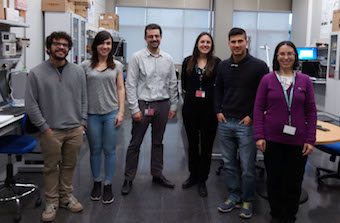
The IRIS research group (IFMED-IFIC) has just published in the magazines Frontiers in Oncology and Physics in Medicine the results that show the validity of a new Compton telescope for hadrontherapy. The new system aims to effectively determine the place where radiation is deposited in this type of therapy against tumours, a decisive aspect in its clinical application.
One of the critical factors in making the most of the benefits of so-called hadronic therapy against cancer is to know exactly where the energy of the heavy particles that it uses is being deposited. Different techniques are currently being developed to test it while treating the patient. The IRIS research group of the new facility in Medical Physics (IFIMED) of the Institute for Corpuscular Physics (IFIC, CSIC-UV), works on a type of camera with detectors similar to those used to detect particles produced in the Large Hadron Collider (LHC) of CERN, but adapted to the clinical setting. It is a three-layer Compton telescope, a system capable of determining where heavy particles leave their energy in the patient effectively. The first published results indicate the viability of this new technique.
Unlike conventional radiotherapy, hadrontherapy uses heavy charged particles to irradiate the tumour. These particles, protons in most cases, deposit almost all the energy with which they are emitted at the end of their trajectory, which is known as 'Bragg peak'. The idea of using them against cancer is that this peak coincides with the place where the tumour is placed, since this way a lower dose is deposited in healthy tissue. In addition to this, heavy particles destroy the tumour more effectively than photons.
However, it is difficult to determine that they actually leave this energy in the place where the tumour is: while in conventional radiotherapy the photons that leave the body are detected to determine the process (affecting in its passage other tissues), in hadrontherapy the type of interaction of the heavy particles with the tumour does not allow a simple detection.
The fifty centres that provide this therapy around the world are using PET scanners (Positron emission tomography) to monitor the therapy. PET detects the photons that are generated by annihilating the antiparticles of the electron, produced during irradiation, with the electrons of the tissue. But this method has limitations: in addition to the low efficiency of the system (few positrons are generated), this type of monitoring is usually done after irradiation (where changes occur in the body) and it is difficult to integrate the devices into the hadrontherapy rooms, which require large and expensive particle accelerators to emit the beam with the desired energy.
‘An alternative is to use the gamma radiation that produces the interaction, more abundant and or a more immediate production’, explains Gabriela Llosá, researcher of the IRIS group (Image Reconstruction, Instrumentation and Simulations for medical applications) in the IFIC-IFIMED. It is beginning to be tested in hadronic therapy centres with the so-called 'collimated cameras', a system that offers a simple, one-dimensional image of what happens during hadrontherapy in the patient's body. The IFIMED team, where Llosá works, develops an alternative system: a Compton telescope, a chamber made up of three layers of lanthanum bromide (LaBr3) that 'sparkle' on contact with the gamma particles.
‘This system determines more efficiently where the radiation in hadrontherapy is placed’, says Llosá. The advantage of this system compared to the collimated cameras is that this makes a better use of the gamma radiation produced in the interaction, so it offers more information about the deposition of energy in the tissue. The detection principle is similar to that used by large detectors that reconstruct what happens in the particle collisions of CERN's Large Hadron Collider (LHC), where the IFIC has extensive experience in both the construction and operation of several of their experiments.
Nevertheless, to apply these principles of basic research to the clinical one is complex: firstly, ‘you should develop a small device which can be placed at the hadrontherapy room at the same time that the treatment is taking place’, says Llosá. In order to improve the efficacy of the device, the team led by Gabriela Llosá and Josep Oliver has included a third layer in the camera, whose images were published in the magazine Frontiers in Oncology.
Moreover, the system, named MACACO (Compton camera for medical applications), has been tested for the first time with protons beams in the AGOR cyclotron of the KVI - Centre for Advanced Radiation Technology of the University of Groningen (the Netherlands). The results are published in Physics in Medicine and Biology. According to Llosá, this evidence show the viability of the method. However, a greater effort is required to reach the necessary precision for its clinical application and to fund its development.
More information:
First Images of a Three-Layer Compton Telescope Prototype for Treatment Monitoring in Hadron Therapy, Gabriela Llosá, Marco Trovato, John Barrio, Ane Etxebeste, Enrique Muñoz, Carlos Lacasta, Josep F. Oliver, Magdalena Rafecas, Carles Solaz and Paola Solevi. Front. Oncol.,
http://dx.doi.org/10.3389/fonc.2016.00014
Performance of MACACO Compton telescope for ion-beam therapy monitoring: first test with proton beams, Paola Solevi, Enrique Muñoz, Carles Solaz, Marco Trovato, Peter Dendooven, John E Gillam, Carlos Lacasta, Josep F Oliver, Magdalena Rafecas, Irene Torres-Espallardo and Gabriela Llosá. 2016 Phys. Med. Biol. 61 5149
http://iopscience.iop.org/0031-9155/61/14/5149
Last update: 26 de january de 2017 09:50.
News release



















